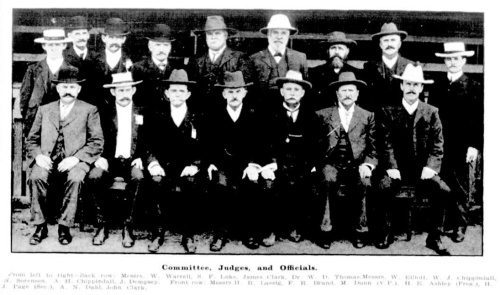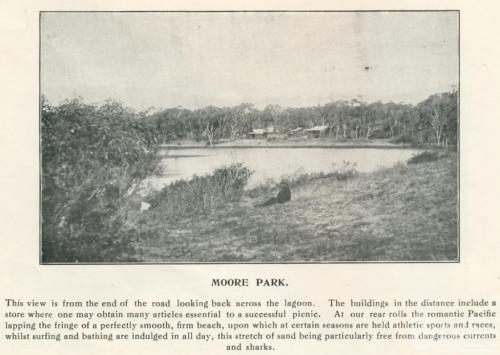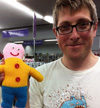After our quick look at Hermann Lassig and his business career, let’s try to find out what land he owned and when – in particular, whether he owned a cane farm during the period of South Sea Islander labour.

Hermann Lassig (front row, far left) at the Bundaberg Show, June 1907. Although, I know you’re all looking at the dude in the cowboy hat at the far right… (Australian Town & Country Journal, 12 June 1907, p. 27, via Trove)
Now, I said last time that Hermann moved from Maryborough to Bundaberg “at some point.” That’s because the details of exactly when are a bit sketchy, considering I’m piecing things together mostly from official records and newspaper articles.
However, there is an intriguing mention on page 61 of Neville Rackemann’s history of the (now-defunct) Gooburrum Shire Council, Gooburrum 1886-1986. The context is a farewell function given to pioneers of the region, E.C. Zahn and his wife:
H. Lassig spoke of meeting Mr Zahn in 1881, when, ‘The Gooburrum then was scrub, with a track cut through, and Mr Zahn was one of its pioneers.’ He went on to praise Zahn for the leading role he had played in the establishment of the North Coast Sports Club. (North Coast was later named Moore Park.)
1881! That’s 7 years before he married Mary Ann Seeds, which is the next earliest reference I have.
Mr Rackemann also records that Hermann “took up land”, probably on Rosedale Road – which is enticingly close to the Carlton property from where the bell comes. So did he own a cane farm at this stage?
I cannot say for sure, but I think it’s unlikely. Land selection under the Sugar and Coffee Regulations 1864 is recorded in the Queensland State Archives, and the name Lassig doesn’t show up there. Nor does it show up in other lists of land selectors I’ve seen, such as in the Gooburrum book.
But this shouldn’t be a surprise. Early sugar plantations were massive, labour-intensive operations, where the crop was grown, harvested and processed on the one property. It was only as transportation improved and technology enabled large, mechanised, central mills, that small, family-run farms became viable.
So it seems quite improbable that the 18-year-old son of German immigrant farm workers had the capital to set up such a large enterprise, let alone import labour from the Pacific Islands. More likely, he worked to save up money that he then put into starting his butcher business.
And according to Rackemann, many of the new immigrants on smaller blocks grew other, more manageable crops: “Maize was the first crop grown along with some arrowroot that was usually planted by German migrants.” (p. 60)
There’s a big gap till the next official location record I’ve found, which is from the 1903 Electoral Roll. It lists Hermann as a butcher living with Mary Ann at Gavan Street, North Bundaberg. I’m going to go ahead and assume that’s actually Gavin Street, which is the current spelling.
He’s still listed at Gavan Street in the 1905 Electoral Roll, but that same year he also bought the 210 acre (85 ha) sugar plantation Seaview, in Woongarra near Bargara (The Brisbane Courier, 23 August 1905, p. 6).
Although he sold Seaview two years later for between £4000 and £5000 (The Brisbane Courier, 18 April 1907, p. 2), this does overlap with the end of the Pacific labour trade. So this is quite possibly one of the clues we’re looking for.
After that, he moved to a different kind of farming, purchasing the much larger Yarrol Station on the Upper Burnett, northwest of Mount Perry (The Brisbane Courier, 17 October 1908, p. 5).

Yarrol Station and homestead, showing the grass for grazing. The date is unknown, but probably about 1890 because there’s another photo with that date (John Oxley Library, State Library of Queensland)
Yarrol was described as comprising “45 square miles (117 sq km) of leasehold, and 24 square miles (62 sq km) under occupation license, together with a grazing farm of 4600 acres (1862 ha).” It also included “2000 head of shorthorn cattle and sixty horses.” So, definitely not a cane farm.
Hermann owned Yarrol until 1917-18 (The Farmer and Settler, 8 February 1918, p. 3). But being such a long way from anywhere, including his butcher shops, it’s unlikely he and his family actually lived there.
Instead, it’s around this time that they moved to the Carlton property, on Moore Park Road. Hermann is recorded as living there in the Electoral Rolls for 1913 and 1925, and both list his occupation as “grazier”. Which would be odd, if Carlton was indeed a cane farm; but then that could be referring to his main source of income being cattle on the Yarrol Station.
Either way, he appears to have remained at Carlton until “leaving to reside in another part of the district” in 1927 (The Brisbane Courier, 9 May 1927, p. 23). That would seem to be the beachside settlement of Moore Park, 15 km north of Bundaberg.

From The Burnett and Isis Pictorial, Richards & Kingdon, Bundaberg, 1927, collection of Centre for the Government of Queensland (via Queensland Places)
Although whenever I’ve gone there I’ve been stung by sand whipped up by strong winds, I guess it’s not too bad a place to retire when you’re, what, 64? And to this day, there’s a Lassig Street named in Hermann’s honour.
Of all of these properties, Seaview seems the most likely to have used South Sea Islander labour – given the timeframe involved.
But what about the bell that started this investigation? Didn’t it supposedly come from Carlton?
Let’s face it, despite all the records of where he lived, Hermann was clearly a man who had a number of things going on at once. It’s quite likely his ownership of Carlton overlapped with some of the other enterprises listed here.
I guess it’s back to the Queensland land records to try to find out…








